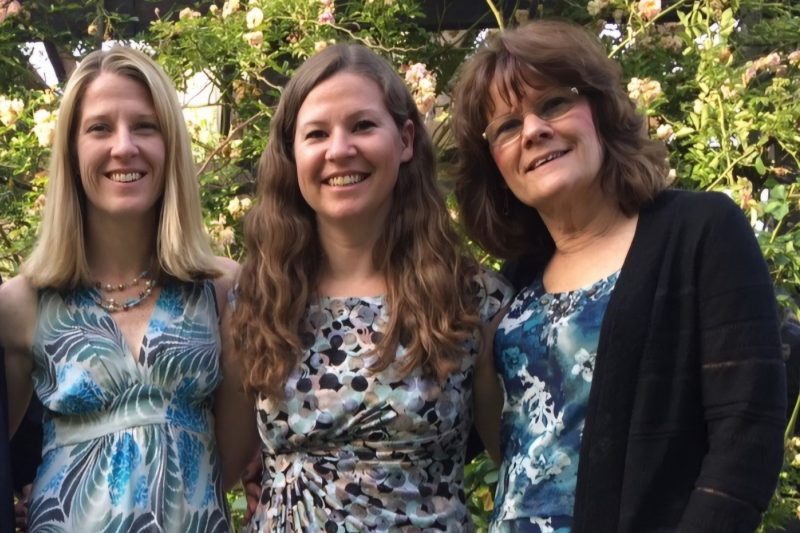PUBLISHED: 16th May 2024

by Jayme Brindle
Breast cancer risk related to gene mutations, especially BRCA1 and BRCA2 mutations, is getting more publicity. But what about those of us who are gene mutation-negative but have a strong family history of breast cancer?
Breast cancer rocked my world when I was in college. I was shocked and devastated when my aunt’s cancer returned and spread after many years of remission; she died in her early 50s. Only later did I learn that she was initially diagnosed at age 36. About a decade later, my mother was diagnosed with early-stage breast cancer in her late 50s. With her family history, she decided to be more aggressive with treatment, including mastectomy, to avoid future biopsies and stress. This was the first of my many experiences as a caregiver.
Breast cancer in the family shaped my decisions about health and future
As more family members were diagnosed with breast cancer—8 of 12 women on my mom’s side—I knew my risk was increasing. However, not until I helped my 36-year-old sister, my only sibling, through her breast cancer diagnosis and challenging treatments did this become more real and personal for me. When my sister was told she had just a seven percent chance of recurrence after a double mastectomy, chemo and starting tamoxifen, we all exhaled in relief. However, less than two years later, she was diagnosed with stage 4 cancer that had spread quickly to her bones and liver. She bravely tried another round of chemo, but she died less than three months later at age 38. We were best friends, and her loss was and still is unbelievable.
Once I could somewhat breathe again, I saw my sister’s oncologist to address my risk of breast cancer. I was told I was in a high-risk category, despite my mother and sister testing negative for a gene mutation. We are part of the 50 percent of the population with inherited breast cancer risk that does not test positive for any known gene mutations. Using a breast cancer risk assessment tool, my oncologist estimated my risk to be 38 percent, greater than a 1-in-3 chance of getting breast cancer. The standard protocol for this risk level recommends increased surveillance, but because of my high risk, insurance would pay for prophylactic surgery.
Initially, I took the more conservative approach of increased surveillance, alternating MRI and mammograms every six months. I also began taking a recommended estrogen modulator medication. However, I still had to deal with the stress of each test, the cost of the MRI, the agony of waiting for results, the side-effects of the medication and continually worrying about my risk. Even more startling was what my oncologist said: If I developed breast cancer, he would not treat me differently than my sister, as that was the standard treatment protocol. It was clear that the only way to increase my chances of living to an old age was to never get cancer.
Making hard decisions
After carefully weighing my options, having second opinions and talking with a counselor, I decided to take more control over my future. To decrease my chances of having future biopsies and/or chemo if cancer was found, I elected to have a preventive bilateral mastectomy. Fortunately, I had a supportive spouse, had completed having children and was a candidate for a single surgery with double mastectomy and direct-to-implant reconstruction.
I felt solid in my decision but was surprised at others’ reactions. Many felt my decision-making was “too aggressive” and “rash.” They downplayed my family history/experience, saying they would understand my choice if I had a BRCA mutation and asking, “But what if you never developed breast cancer anyway?” I realized they did not share my experiences and could not understand and appreciate how carefully I had weighed my decision. My decision was more difficult because even though my risk was lower than those with a BRCA mutation, it was still more than double that of the general female population, and my sister's and aunt’s breast cancers had been very aggressive, and ultimately, untreatable.
FORCE helped me, now I help others
Thankfully, I found FORCE while looking for resources on how to inform my children about my surgery. I was relieved to discover well-researched information about situations like mine. FORCE’s amazing peer navigation was especially helpful. I was matched with a woman with similar demographics: high family risk, negative mutation status and preventive mastectomy. For the first time, I did not feel alone! I was reassured that I was making a calculated decision to manage my increased risk and was not being impulsive or imprudent. That conversation inspired me to become a peer navigator as well.
So far, I have helped 10 other women on a similar journey. I can address with firsthand experience the topics that a doctor can only address secondhand, such as postsurgery sensation, intimacy, doubts, partner’s reactions, helpful items to purchase before surgery, etc. Looking back, my challenging situation has been rewarding and positive. In addition to the joy of bringing relief to these women, this experience has been an amazing way to honor my sister and all of my family members who were warriors against breast cancer.
My surgery went smoothly without complications. Now recovered, I rarely think about my breast cancer risk. I have never second-guessed my decision and would gladly make the same decision again. For me, the positives far outweigh the negatives.
POSTED IN: Voices , Hereditary Cancer - General
TAGS: Hereditary Cancer , Genetic Counseling , Variants Of Uncertain Significance , Coping With Risk
1 Comments
May 23, 2024
Jayme Brindle's story is a poignant reminder that breast <a href="https://www.books.ipinnovative.com/books/medical">cancer</a> risk isn't always determined by genetic testing. Her journey, marked by loss and resilience, underscores the importance of personalized risk assessment and proactive decision-making. Brindle's advocacy work with organizations like FORCE highlights the power of peer support in navigating challenging medical decisions.
Harshit Behl
Reply